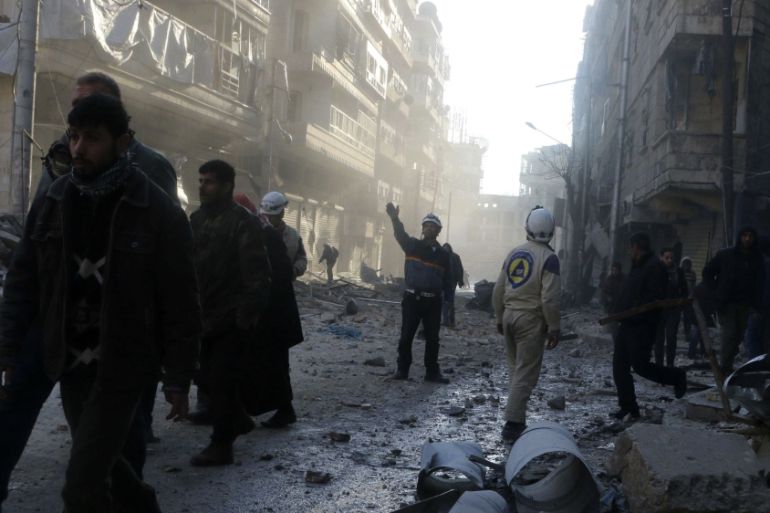Aleppo is symbolic of the coming apart of Syria
Aleppo’s history is being destroyed, economy strangled and its society turned against one another.

Syria’s largest city is also the biggest symbol of the damage wrought by the conflict. New drone footage showing Aleppo’s neighbourhoods of rubble have been headlined as “shocking” but to those who have been watching the steady grind of artillery fire and barrel bombs it comes as no real surprise.
The Economist described the Aleppo as a “shadow of its former self“. History is being made; history as a world heritage site is being erased by high explosives and a ceaseless exchange of small arms fire.
Keep reading
list of 4 itemsAustin confirms Russians deployed to airbase housing US military in Niger
What’s next as ‘heavy-handed’ US negotiates pullout from Niger?
Putin says ‘radical Islamists’ behind Moscow concert hall attack
The rise and rise of ISIL has focused attention to the east and the narratives of Kobane and Raqqa. Aleppo lacks a unifying theme and its complex array of opposition groups controlling different neighbourhoods and streets is perhaps best displayed in the maps that show how fractured the city has become.
|
|
Yet Aleppo has seemingly moved centre stage in the conflict with the Syrian army (and its allies) looking to surround the rebel controlled parts of the city and then potentially use a combination of starvation and barrel bombs to flush out remaining opposition.
Six weeks of calm
The man with the hardest job in the world, UN special envoy Staffan de Mistura, is in Damascus today to push for a pause in the bombardment of Aleppo as part of his mission for six weeks of calm. Critics argue that while local ceasefires sound good in principle – slowing down the death rates and allowing rare aid access – they are actually cover for redeployments and the tightening of attacks on the more distant supply lines that allow opposition groups to remain viable.
Khaled Khoja, president of the National Coalition of Syrian Revolutionary and Opposition Forces, said this month that: “The past four years have revealed the regime’s goal behind these local truces, which is to gain more time and escalate attacks on the rebel-held areas.”
Some commentatorshave even described previous “local ceasefires” as a euphemism for surrender.
A renowned place of trade has now become defined by the exchange of hell cannon fire and barrel bombs in a desperate rush towards Syria's demise as a functioning state.
How easy is it to trust regime promises to halt fighting for six weeks when Bashar al-Assad has shown himself capable of flatly denying his army’s use of barrel bombs in the conflict? The only genuine “freeze” to fighting in Syria appears to have been linked to terrible weather conditions rather than any moves towards rapprochement between opposition elements and the regime. Meanwhile, the notion that the regime’s momentum has been consistently on the front foot was debunked by reports from the Syrian Observatory for Human Rights of 129 Assad soldiers being killed last Saturday in fierce battles around Aleppo.
Battered city
Aleppo itself is a battered city where houses have become tombs and neighbourhoods fields of rubble that are testament to the futility of conflict. A renowned place of trade has now become defined by the exchange of hell cannon fire and barrel bombs in a desperate rush towards Syria’s demise as a functioning state. However, one rare moment of hope against such bleakness has been the emergence of Syria’s “White Helmets” heroes – the volunteer rescue workers who make up the “Syrian Civil Defence” and are reported to have saved some 12,521 lives from the deadly piles of rubble – including an 80-year-old woman this weekend.
If the city’s homes are now its graves its waterways has also become defined by death. The main canal has been termed the “River of Martyrs” due to the regular jetsam and flotsam comprised of bound and hooded victims of execution. The city has been largely functioning as two distinct entities for years now – separating families and even lovers as the demarcation becomes more complete.
Aleppo is symbolic of the coming apart of Syria – its history destroyed, its economy strangled and its society turned against one another.
Yet de Mistura remains focused on delivering six-weeks of calm to a city that has not slept for years. He described the apparent temporary ceasefire deal as a “glimmer of hope” and that this pause, rather than a wider peace, is the yardstick for success shows how deeply rooted the conflict has become almost four years since it started with protests in Deraa. The “Arab Spring” that filled the air with such hope has been seemingly replaced by a ceaseless “Aleppo Winter” of suffering and loss that shows no sign of ending.
James Denselow is a writer on Middle East politics and security issues and a research associate at the Foreign Policy Centre.
The views expressed in this article are the author’s own and do not necessarily reflect Al Jazeera’s editorial policy.
